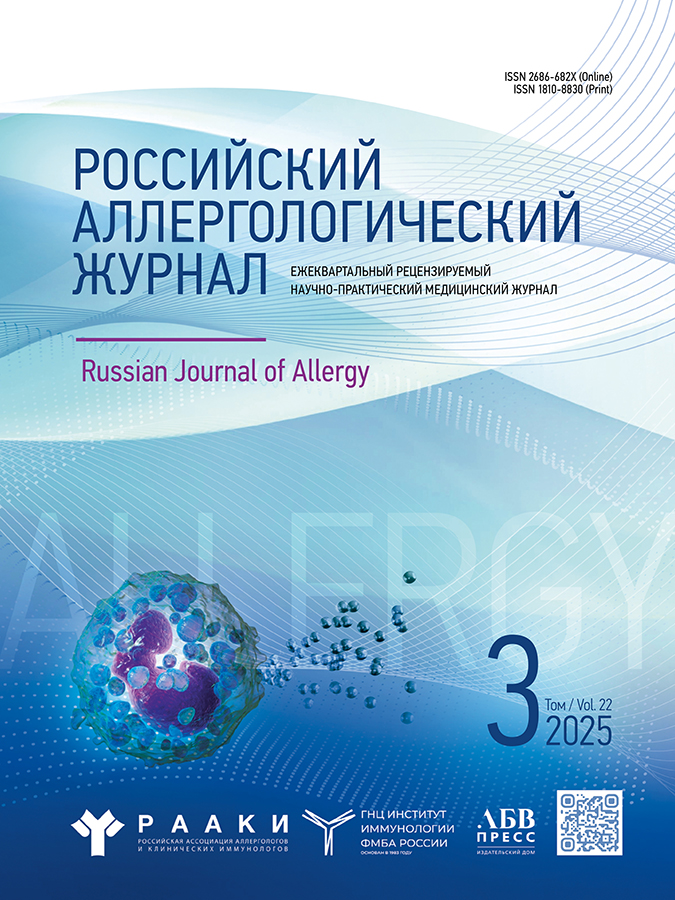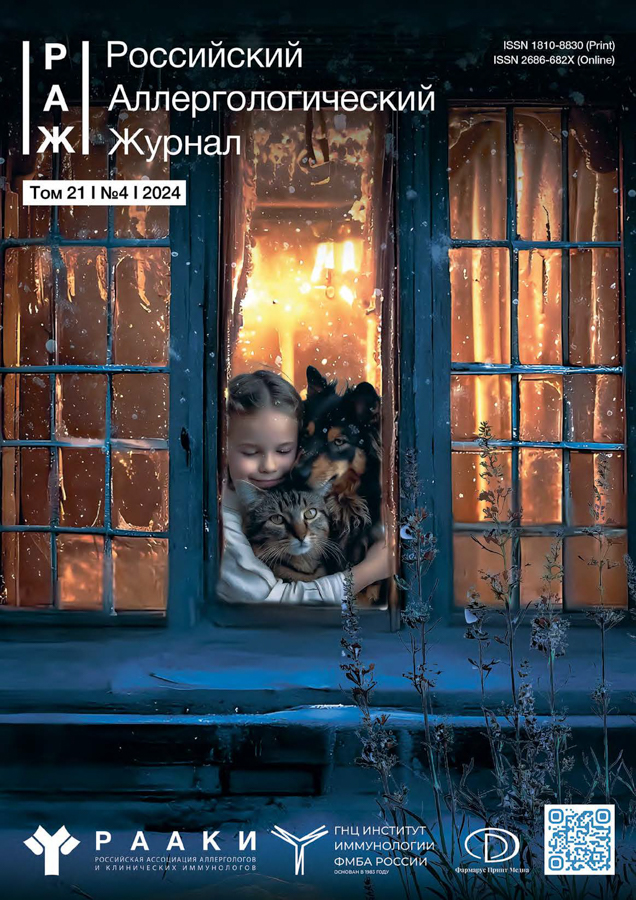GATA2 deficiency: a long way to diagnosis (case report)
- Authors: Avgustovskaya I.S.1,2, Roppelt A.A.1, Markina U.A.1, Gogol A.L.1, Beloglazova I.P.1,3, Korennaya V.V.1,4, Karaulov A.V.2, Nurtazina A.Y.2, Lysenko M.A.1,3, Fomina D.S.1,2,5
-
Affiliations:
- Clinical City Hospital No. 52
- The First Sechenov Moscow State Medical University (Sechenov University)
- The Russian National Research Medical University named after N.I. Pirogov
- Russian Medical Academy of Continuous Professional Education
- Astana Medical University
- Issue: Vol 21, No 4 (2024)
- Pages: 540-553
- Section: Case reports
- Submitted: 28.09.2024
- Accepted: 10.12.2024
- Published: 28.12.2024
- URL: https://rusalljournal.ru/raj/article/view/16973
- DOI: https://doi.org/10.36691/RJA16973
- ID: 16973
Cite item
Abstract
GATA2 deficiency is a form of inborn errors of immunity (or primary immunodeficiencies) with a wide range of symptoms. According to the international classification of primary immunodeficiency diseases it is classified as congenital defects of phagocyte number, function, or both. Heterozygous mutations in the GATA2 gene cause syndromes reported in the literature as dendritic cell, monocyte, B and NK lymphoid deficiency, MonoMAC syndrome (monocytopenia and mycobacterial infection), familial myelodysplastic syndrome, and Emberger syndrome (the combination of myelodysplasia and congenital lymphedema).
Here we present a literature review on GATA2 deficiency and report a clinical case of an adult woman with the abovementioned immune defect, the results of laboratory and instrumental examinations, therapy, and outcome. The patient’s condition was complicated by lymphedema, myelodysplastic syndrome, endometrial carcinoma in situ, nonspecific pulmonary lesion, recurrent miscarriage, and rheumatic conditions (erythema nodosum). The mentioned diversity of clinical manifestations is a reason for long diagnostic search, as well as difficulties in diagnosis and selection of optimal treatment tactics.
Full Text
About the authors
Irina S. Avgustovskaya
Clinical City Hospital No. 52; The First Sechenov Moscow State Medical University (Sechenov University)
Author for correspondence.
Email: is-avgustovskaya@mail.ru
ORCID iD: 0009-0000-0043-5985
Moscow Center of Allergy and Immunology
Россия, Moscow; MoscowAnna A. Roppelt
Clinical City Hospital No. 52
Email: roppelt_anna@mail.ru
ORCID iD: 0000-0001-5132-1267
SPIN-code: 7249-4423
MD, Cand. Sci. (Medicine)
Россия, MoscowUlyana A. Markina
Clinical City Hospital No. 52
Email: itcher.md@bk.ru
ORCID iD: 0000-0002-6646-4233
Moscow Center of Allergy and Immunology
Россия, MoscowAnna L. Gogol
Clinical City Hospital No. 52
Email: catharsis17@yandex.ru
ORCID iD: 0009-0005-1988-1703
Россия, Moscow
Irina P. Beloglazova
Clinical City Hospital No. 52; The Russian National Research Medical University named after N.I. Pirogov
Email: beloglazova.irina@gmail.com
ORCID iD: 0000-0002-2266-1497
SPIN-code: 5339-8420
MD, Cand. Sci. (Medicine)
Россия, Moscow; MoscowVera V. Korennaya
Clinical City Hospital No. 52; Russian Medical Academy of Continuous Professional Education
Email: drkorennaya@mail.ru
ORCID iD: 0000-0003-1104-4415
SPIN-code: 9940-6413
MD, Cand. Sci. (Medicine), Assistant Professor
Россия, Moscow; MoscowAlexander V. Karaulov
The First Sechenov Moscow State Medical University (Sechenov University)
Email: drkaraulov@mail.ru
ORCID iD: 0000-0002-1930-5424
SPIN-code: 4122-5565
MD, Dr. Sci. (Medicine), Professor
Россия, MoscowAsel Yu. Nurtazina
The First Sechenov Moscow State Medical University (Sechenov University)
Email: asel26nurtazina@mail.ru
ORCID iD: 0000-0002-2337-3307
SPIN-code: 5028-4695
Cand. Sci. (Medicine), Assistant Professor
Россия, MoscowMaryana A. Lysenko
Clinical City Hospital No. 52; The Russian National Research Medical University named after N.I. Pirogov
Email: gkb52@zdrav.mos.ru
ORCID iD: 0000-0001-6010-7975
SPIN-code: 3887-6250
MD, Dr. Sci. (Medicine), Professor
Россия, Moscow; MoscowDarya S. Fomina
Clinical City Hospital No. 52; The First Sechenov Moscow State Medical University (Sechenov University); Astana Medical University
Email: daria_fomina@mail.ru
ORCID iD: 0000-0002-5083-6637
SPIN-code: 3023-4538
Moscow Center of Allergy and Immunology, MD, Cand. Sci. (Medicine), Assistant Professor
Россия, Moscow; Moscow; Astana, KazakhstanReferences
- Tangye SG, Al-Herz W, Bousfiha A, et al. Human inborn errors of immunity: 2022 update on the Classification from the International Union of Immunological Societies Expert Committee. J Clin Immunol. 2022;42(7):1473–1507. doi: 10.1007/s10875-022-01289-3
- Fabozzi F, Mastronuzzi A, Ceglie G, et al. GATA 2 deficiency: focus on immune system impairment. Front Immunol. 2022;13:865773. doi: 10.3389/fimmu.2022.865773
- Fabozzi F, Strocchio L, Mastronuzzi A, Merli P. GATA2 and marrow failure. Best Pract Res Clin Haematol. 2021;34(2):101278. doi: 10.1016/j.beha.2021.101278
- Dickinson RE, Griffin H, Bigley V, et al. Exome sequencing identifies GATA-2 mutation as the cause of dendritic cell, monocyte, B and NK lymphoid deficiency. Blood. 2011;118(10):2656–2658. doi: 10.1182/blood-2011-06-360313
- Ling KW, Ottersbach K, van Hamburg JP, et al. GATA-2 plays two functionally distinct roles during the ontogeny of hematopoietic stem cells. J Exp Med. 2004;200(7):871–882. doi: 10.1084/jem.20031556
- Koyunlar C, de Pater E. From basic biology to patient mutational spectra of GATA2 haploinsufficiencies: what are the mechanisms, hurdles, and prospects of genome editing for treatment. Front Genome Ed. 2020;2:602182. doi: 10.3389/fgeed.2020.602182
- Peters IJA, de Pater E, Zhang W. The role of GATA2 in adult hematopoiesis and cell fate determination. Front Cell Dev Biol. 2023;11:1250827. doi: 10.3389/fcell.2023.1250827
- Rodrigues NP, Boyd AS, Fugazza C, et al. GATA-2 regulates granulocyte-macrophage progenitor cell function. Blood. 2008;112(13):4862–4873. doi: 10.1182/blood-2008-01-136564
- Collin M, Dickinson R, Bigley V. Haematopoietic and immune defects associated with GATA2 mutation. Br J Haematol. 2015;169(2):173–187. doi: 10.1111/bjh.13317
- Wlodarski MW, Hirabayashi S, Pastor V, et al. Prevalence, clinical characteristics, and prognosis of GATA2-related myelodysplastic syndromes in children and adolescents. Blood. 2016;127(11):1387–1518. doi: 10.1182/blood-2015-09-669937
- Calvo KR, Hickstein DD. The spectrum of GATA2 deficiency syndrome. Blood. 2023;141(13):1524–1532. doi: 10.1182/blood.2022017764
- Spinner MA, Sanchez LA, Hsu AP, et al. GATA2 deficiency: a protean disorder of hematopoiesis, lymphatics, and immunity. Blood. 2014;123(6):809–821. doi: 10.1182/blood-2013-07-515528
- Homan CC, Venugopal P, Arts P, et al. GATA2 deficiency syndrome: a decade of discovery. Hum Mutat. 2021;42(11):1399–1421. doi: 10.1002/humu.24271
- Mace EM, Hsu AP, Monaco-Shawver L, et al. Mutations in GATA2 cause human NK cell deficiency with specific loss of the CD56(bright) subset. Blood. 2013;121(14):2669–2677. doi: 10.1182/blood-2012-09-453969
- Johnson KD, Hsu AP, Ryu MJ, et al. Cis-element mutated in GATA2-dependent immunodeficiency governs hematopoiesis and vascular integrity. J Clin Invest. 2012;122(10):3692–3704. doi: 10.1172/JCI61623
- Dancy E, Stratton P, Pichard DC, et al. Human papillomavirus disease in GATA2 deficiency: a genetic predisposition to HPV-associated female anogenital malignancy. Front Immunol. 2024;15:1445711. doi: 10.3389/fimmu.2024.1445711
- Pasquet M, Bellanné-Chantelot C, Tavitian S, et al. High frequency of GATA2 mutations in patients with mild chronic neutropenia evolving to MonoMac syndrome, myelodysplasia, and acute myeloid leukemia. Blood. 2013;121(5):822–829. doi: 10.1182/blood-2012-08-447367
- Maciejewski-Duval A, Meuris F, Bignon A, et al. Altered chemotactic response to CXCL12 in patients carrying GATA2 mutations. J Leukoc Biol. 2016;99(6):1065–1076. doi: 10.1189/jlb.5MA0815-388R
- Fujiwara T. GATA transcription factors: basic principles and related human disorders. Tohoku J Exp Med. 2017;242(2):83–91. doi: 10.1620/tjem.242.83
- Raziq FI, Abubaker A, Smith E, Uddin M. Secondary pulmonary alveolar proteinosis in GATA-2 deficiency (MonoMAC syndrome). BMJ Case Rep. 2020;13(11):e238290. doi: 10.1136/bcr-2020-238290
- Ostergaard P, Simpson MA, Connell FC, et al. Mutations in GATA2 cause primary lymphedema associated with a predisposition to acute myeloid leukemia (Emberger syndrome). Nat Genet. 2011;43(10):929–931. doi: 10.1038/ng.923
- Østergård S, Vorbeck CS, Meinert M. [Vulvar intraepithelial neoplasia]. Ugeskr Laeger. 2018;180(20):V12170931. [In Danish].
- Selitsky SR, Marron D, Mose LE, et al. Epstein–Barr virus-positive cancers show altered B-cell clonality. mSystems. 2018;3(5):e00081-18. doi: 10.1128/mSystems.00081-18
- Cohen JI, Dropulic L, Hsu AP, et al. Association of GATA2 deficiency with severe primary Epstein–Barr virus (EBV) infection and EBV-associated cancers. Clin Infect Dis. 2016;63(1):41–47. doi: 10.1093/cid/ciw160
- Kazenwadel J, Secker GA, Liu YJ, et al. Loss-of-function germline GATA2 mutations in patients with MDS/AML or MonoMAC syndrome and primary lymphedema reveal a key role for GATA2 in the lymphatic vasculature. Blood. 2012;119(5):1283–1291. doi: 10.1182/blood-2011-08-374363
- Mammoto A, Connor KM, Mammoto T, et al. A mechanosensitive transcriptional mechanism that controls angiogenesis. Nature. 2009;457(7233):1103–1108. doi: 10.1038/nature07765
- Amarnani AA, Poladian KR, Marciano BE, et al. A panoply of rheumatological manifestations in patients with GATA2 deficiency. Sci Rep. 2020;10(1):8305. doi: 10.1038/s41598-020-64852-1
- Frolov EA, Abdulaeva FI, Gornostaeva UA, et al. Features of the clinical picture and course of GATA2 deficiency complicated by generalized verrucosis with an outcome in myelodysplastic syndrome in adulthood. Medical Herald of the South of Russia. 2023;14(4):35–43. (In Russ). doi: 10.21886/2219-8075-2023-14-4-35-43
- Basheer A, Padrao EMH, Huh K, et al. Pulmonary alveolar proteinosis due to familial myelodysplastic syndrome with resolution after stem cell transplant. Autops Case Rep. 2022;12:e2021382. doi: 10.4322/acr.2021.382
- Maeurer M, Magalhaes I, Andersson J, et al. Allogeneic hematopoietic cell transplantation for GATA2 deficiency in a patient with disseminated human papillomavirus disease. Transplantation. 2014;98(12):e95–e96. doi: 10.1097/TP.0000000000000520
- Parta M, Cole K, Avila D, et al. Hematopoietic cell transplantation and outcomes related to human papillomavirus disease in GATA2 deficiency. Transplant Cell Ther. 2021;27(5):435.e1–435.e11. doi: 10.1016/j.jtct.2020.12.028
- De Witte T, Bowen D, Robin M, et al. Allogeneic hematopoietic stem cell transplantation for MDS and CMML: recommendations from an international expert panel. Blood. 2017;129(13):1753–1762. doi: 10.1182/blood-2016-06-724500
- Bortnick R, Wlodarski M, de Haas V, et al. Hematopoietic stem cell transplantation in children and adolescents with GATA2-related myelodysplastic syndrome. Bone Marrow Transplant. 2021;56(11):2732–2741. doi: 10.1038/s41409-021-01374-y
- Nichols-Vinueza DX, Parta M, Shah NN, et al. Donor source and post-transplantation cyclophosphamide influence outcome in allogeneic stem cell transplantation for GATA2 deficiency. Br J Haematol. 2022;196(1):169–178. doi: 10.1111/bjh.17840
- Parta M, Shah NN, Baird K, et al. Allogeneic hematopoietic stem cell transplantation for GATA2 deficiency using a busulfan-based regimen. Biol Blood Marrow Transplant. 2018;24(6):1250–1259. doi: 10.1016/j.bbmt.2018.01.030
- Hofmann I, Avagyan S, Stetson A, et al. Comparison of outcomes of myeloablative allogeneic stem cell transplantation for pediatric patients with bone marrow failure, myelodysplastic syndrome and acute myeloid leukemia with and without germline GATA2 mutations. Biol Blood Marrow Transplant. 2020;26(6):1124–1130. doi: 10.1016/j.bbmt.2020.02.015
- Tichelli A, Rovó A. Fertility issues following hematopoietic stem cell transplantation. Expert Rev Hematol. 2013;6(4):375–388. doi: 10.1586/17474086.2013.816507
- Skvortsova YuV, Papusha LI, Rudneva AE, et al. Pathology of the reproductive system after allogeneic hematopoietic stem cell transplantation in children: a single center experience. Russian Journal of Hematology and Transfusiology. 2017;62(3):124–134. (In Russ). doi: 10.18821/0234-5730-2017-62-3-124-134
Supplementary files







